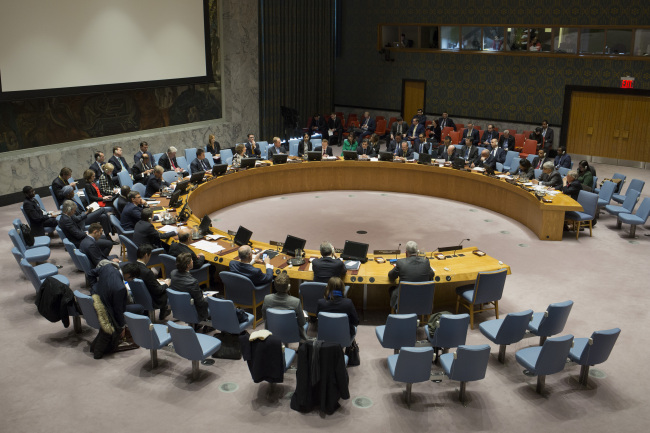UNSC condemns NK missile launch as defense debate heats up
By Shin Hyon-heePublished : Feb. 14, 2017 - 18:17
The UN Security Council late Monday unanimously condemned North Korea’s latest ballistic missile test, as debate heats up here over Seoul’s missile defense capabilities.
The 15 council members issued a press statement after an emergency meeting in New York upon a request from Seoul, Washington and Tokyo. Sunday’s launch was a grave violation of UNSC resolutions banning the North’s nuclear and missile tests, they said, deploring all the activities that boost the country’s nuclear capabilities and fuel tension.
The 15 council members issued a press statement after an emergency meeting in New York upon a request from Seoul, Washington and Tokyo. Sunday’s launch was a grave violation of UNSC resolutions banning the North’s nuclear and missile tests, they said, deploring all the activities that boost the country’s nuclear capabilities and fuel tension.

“The members of the Security Council agreed that the Security Council would continue to closely monitor the situation and take further significant measures, in line with the Council’s previously expressed determination,” the statement reads.
The latest test, in which the Kim Jong-un regime unveiled a new intermediate-range ballistic missile with a range of up to 2,000 to 3,000 kilometers, invited stringent condemnation from around the world, including China and Russia, its diplomatic and economic patrons.
UN Secretary-General Antonio Guterres issued a separate statement strongly denouncing the experiment, urging full compliance with international obligations and denuclearization.
At a joint news conference with Canadian Prime Minister Justin Trudeau, US President Donald Trump singled out the defiant state as a “big, big problem” and pledged to deal with it “very strongly.”
Officials of the defense ministries of Seoul, Washington and Toyo held a video conference early Tuesday, lambasting the provocation and agreeing to continue cooperation including intelligence sharing.
South Korea and the US are seeking to hold their annual Key Resolve and Foal Eagle joint drills, scheduled to kick off next month, at the largest scale like last year. They are currently in consultation over the participation of Washington’s top strategic assets including an aircraft carrier, a nuclear-powered submarine, F-22 stealth fighters and B-1B and B-52 nuclear bombers.
In South Korea, the event is stoking concerns over what critics call porous missile defense. It employed the “cold-launch” method, a solid fuel propelled engine and mobile launcher, which makes it more difficult to detect its launch in advance.
During its briefing to the National Assembly on Tuesday, the National Intelligence Service assessed that the Pukguksong-2 was fired at an angle of 89 degrees and if discharged at a normal angle, it could travel more than 2,000 kilometers.
“(The North) would become a full-fledged nuclear weapons state if it secures warhead miniaturization technologies,” Rep. Lee Cheol-woo, chief of the parliament’s intelligence committee, told reporters, quoting NIS Director Lee Byung-ho as saying.
The missile could be intercepted by the US’ Terminal High Altitude Area Defense system, to be deployed here this year, as it could catch those flying as fast as Mach 14, the spy chief said.
However, he displayed skepticism over the capabilities of the Patriot 2 system -- the existing air defense assets for Seoul and the capital areas -- and the Kill Chain being developed by South Korea for deployment in the early 2020s.
“As for the Patriot 2, it may be possible in theory but wouldn’t it be difficult in a real-life situation?” Lee said. “A pre-emptive strike is implausible because you don’t know where they will be fired from, so the Kill Chain won’t do it. If a pre-emptive strike is undoable, we should go for a preventive strike … but it would risk war.”
But Defense Minister Han Min-koo countered the view, saying the Kill Chain would still be capable of pre-empting an incoming North Korean missile while acknowledging THAAD’s utility.
“The fueling times were already taken into account in our Kill Chain plan. You can’t say the Kill Chain was neutralized just because they changed to solid fuel from liquid fuel,” he said at a separate parliamentary session later in the day.
“The type of missile makes no difference in our capabilities to defend against an incoming missile within the peninsula.”
By Shin Hyon-hee (heeshin@heraldcorp.com)











![[Kim So-hyun] The quiet taxi driver from Paris](http://res.heraldm.com/phpwas/restmb_idxmake.php?idx=644&simg=/content/image/2024/04/25/20240425050891_0.jpg&u=)






